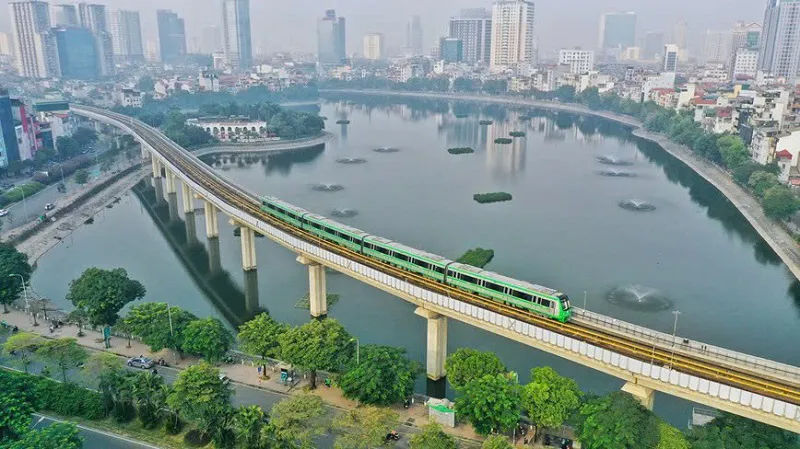Land Law 2024 helps Hanoi accelerate transit-oriented development projects
Transit-oriented development (TOD) is the key to improving Hanoi's urban landscape and transportation.
The 2024 Land Law is a crucial legal framework that will help Hanoi maintain its leadership in public transportation development and urban planning through the Transit Oriented Development (TOD) model. Nguyen Cao Minh, Director of the Hanoi Urban Railway Management Board, talks to The Hanoi Times about the issue.
| Nguyen Cao Minh, Director of the Hanoi Urban Railway Management Board. Photo: The Hanoi Times |
How is TOD helping to shape Hanoi's urban development?
Transit Oriented Development (TOD) is an innovative planning approach that promotes vibrant and sustainable urban growth. By ensuring sustainable mobility and maximizing land use, the TOD model enables cities to make the most of their existing and future public transportation networks with large user bases.
As the capital and a major political, economic and cultural hub of Vietnam, Hanoi has a historic opportunity to incorporate TOD into its long-term urban development strategy. Not only will land use be optimized, but the city will also see a sharp reduction in traffic congestion and emissions while improving the quality of public spaces.
TOD is also a key to unlocking economic potential, increasing land values, and fostering the development of new economic centers. It facilitates the revitalization of critical urban areas through planned land use and urban activities while improving public infrastructure.
Does this mean that TOD helps maximize land resources?
The TOD model doesn't just use land, it enhances the value of land through modern urban planning and development. This model helps the city maximize large investments in public transportation infrastructure, such as urban railways and rapid transit systems, while improving the current housing supply. In addition, the city has the opportunity to develop new housing and economic centers around strategic transit nodes.
As a result, TOD-based initiatives offer opportunities to maximize land value, promote sustainable growth, improve the quality of life for local residents, protect the environment, and move toward a sustainable future.
What is the significance of the Land Law 2024 for the development of a TOD-based city?
The 2024 Land Law introduces special, groundbreaking policies that mark a major turning point for Hanoi and all other localities in Vietnam. Hanoi is leading the country in investing in and building urban railways, public transport and green transport according to the TOD strategy. Therefore, the city urgently needed a flexible legal framework such as the 2024 Land Law.
It's important to remember that TOD is a very new approach for Hanoi. Having a solid policy foundation, such as the 2024 Land Law and the amended Capital Law, will help the city resolve fundamental questions about mechanisms and policies, making it easier to apply TOD principles from the outset and minimizing political risks, challenges, and delays in implementation.
In conclusion, the Land Law 2024, with its landmark reforms, will create a favorable legal framework to help Hanoi lead the way in developing TOD-oriented urban projects. These changes will strengthen the connection between regions, optimize land resources, and build a green, smart, and sustainable city in line with Hanoi's goal of becoming a prosperous, integrated, and distinctive metropolis.
| The Cat Linh-Ha Dong metro line is seen from above. Photo: The Hanoi Times |
What are the most significant advances in the Land Law 2024?
There are three notable features of the 2024 Land Law.
First, the law clarifies and makes more transparent the compensation and resettlement process for land acquisition. This will make it easier for project developers, government agencies and the public to reach a consensus and implement the policy.
Second, Article 159 of the Law requires municipalities and provinces to publish updated land price lists from January 1, 2026. Proposals to amend, supplement or modify the land price lists must be submitted annually by the provincial and municipal people's committees to their respective people's councils for approval and implementation on January 1 of the following year.
This means that land price lists will be updated annually (if adjustments are necessary) instead of every five years as currently required by Article 114 of the 2013 Land Law. In addition to preventing unfairness to homeowners whose homes are subject to land clearance, this new flexible rule will better reflect local land prices and make project planning and investment preparation more realistic.
Third, the 2024 Land Law emphasizes that land pricing must follow market principles, rather than relying on a government-set framework of floor and ceiling prices. The law also includes provisions for on-site resettlement, which will increase public consensus when land is requisitioned for TOD construction. In addition, the law introduces several new provisions that significantly enhance land management and utilization for TOD development in Hanoi and across the country.
Will the Land Law 2024 make land clearance for Hanoi's transportation projects smooth?
Land clearance has always been complicated and challenging, especially in big cities like Hanoi. The 2024 Land Law provides an important legal framework to address these key challenges. Whether it completely solves the problem will depend on how well the law is implemented, applied, and adjusted based on practical experience.
What is certain, however, is that the 2024 Land Law will address the major difficulties in land clearance for transportation and TOD projects. It will meet public expectations regarding land pricing, compensation, and resettlement when land is cleared for development. People may be resettled within TOD developments where their properties are requisitioned, which will encourage public support for projects and government policies. With public support, the long-standing barriers to land clearance will gradually be resolved.
Thank you for your time!












